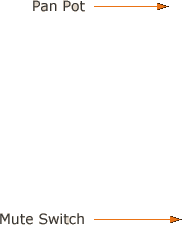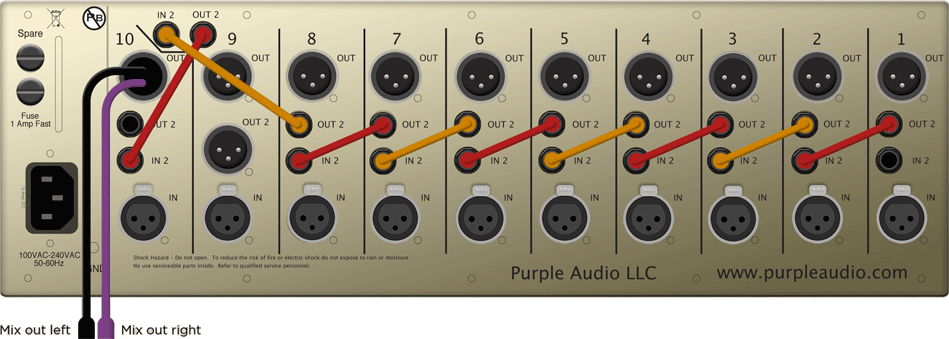

Panner is:
- Single width 500 module
10 Panners fit in a Purple Audio Sweet Ten rack - Stand-alone line level summing module for any line level signal
- Stereo Panner
- Silent Opto Mute
Features
Pan Pot moves a mono signal left to right across the stereo sound stage on the mix buss. Pan law is -6dB. Signal is attenuated -3dB at center position (12 O’clock) from +3dB at full left (7 O’clock) or full right (5 O’clock). When summed to mono, signal will be the same level regardless of pan pot position.
Mute Switch activates an opto-attenuator circuit to silently cut/inject the input signal from/to the mix buss. Mute is engaged when the soft touch push-button switch is actuated. An integral LED will illuminate orange to indicate signal is cut. The activation of this circuit is free of pops, clicks or switching noise and is designed to be used “on the fly” during a mix.
The switch itself was selected for it’s specific “soft touch” which lends itself to two modes of operation: Mute switch can be lightly tapped for immediate activation, or fully depressed and held until activated upon release. The latter operating technique is useful for “counting out the bar” during a metered piece of music. Don’t be afraid to get creative and “play the mutes”.
Passive Stereo Mix Buss Each module contains one channel of a passive stereo summing buss which is expandable to 48 channels. Multiple Panner modules are combined by cross-patching using standard TRS cables (see below).
Passive Summing (it’s a mixer)
Panner is the only stand alone panning/summing module offered in the 500 format, allowing you to turn select racks into a mixer, one channel at a time.
Panner is designed to receive any variety of buss or line level signals, including the buss output of a Channel Amp (when assigned L). With it’s very high input impedance, Panner can also receive any active instrument not needing gain, like a synth.
Of paramount note, this very high input impedance allows the Panner to act as a fader buffer, meaning (with the appropriate cabling) any line level source can be fed to a fader, and the Panner module can receive that fader’s output allowing the option to use a bank of long throw faders with the Panners.
Panner Summing modules will allow you to Sum, Pan, Mute and control your level with a proper analog long throw fader. Perhaps slightly redefining getting out of the box in this format.
When used in conjunction with Channel Amps, a rack of Panners provides a true 4 buss mixing system.

Each Panner module occupies one slot, but carries three signals: line input, mix buss output, and mix buss input.
Referencing the diagram below, Stereo summing is enabled by patching mix out (Out 2) from one Panner to mix in (In 2) of the next. Signals to be panned and summed are received on the female XLR inputs (IN), one mono signal per module. Left/Right mix out is carried via our Mix Buss Cable which patches to the male XLR out (OUT) of the last channel in the chain, channel ten in the diagram below.

Most 500 Series enclosures have just two jacks per slot, providing access only to a Panner’s line input and mix buss output. Purple Audio Sweet Ten racks (as pictured above) have a second set of TRS jacks per slot (Out 2 and In 2) which carry the Panner mix buss signals. This makes Panner stereo summing easy, using stock TRS jumper cables. Presently, Panner stereo summing only works with Purple Audio Sweet Ten, Radial Workhorse, and RTZ Audio UX410 racks.
If you are making your own cables, the Panner buss is Left Channel to Tip, Right Channel to Ring and common ground. The buss on Channel Amps is XLR Pin 2 Left, XLR pin 3 Right, XLR pin 1 common ground. If you plan to put Channel Amps summing in Series with Panners, buss cables should be wired XLR Pin 2 – TRS Tip, XLR pin 3 – TRS Ring and XLR Pin 1 – TRS Sleeve.

By patching outputs to inputs, any collection of Channel Amplifiers and/or Panners can form a summing mixer. Two or more channel amps allows for standalone stereo mixing, and two or more Panners allows for standalone stereo mixing, and a combination of Channel Amps and Panners can form a hybrid stereo mixer, whereby some signals pan across the mix, and other signals are assigned left, center, or right. Larger collections of both types of module can lead to a quad summing setup, or a stereo mixer with separate stereo subgroup. Or you may want to disregard the LCR summing, and patch each channel amp direct output into a corresponding panner line input, using only the panner stereo summing for a more traditional mixing console setup.
In either setup, a high quality long throw fader can be added to each channel for pure analog control.
In any AwTAC summing configuration, a Buss Breakout Cable and additional pair of preamps (or channel amps) are required for termination and makeup gain, because AwTAC modules utilize passive loss summing (aka voltage summing) as was still ubiquitous circa 1970.
Buss Breakout Cables are available from stock, and one is included for free, per customer, with every order of two or more Channel Amplifiers or Panners.
What’s it made of?
Each module is built from the same high quality components as the Channel Amp and features a no-corner-cutting approach to discrete transistor amplifier design. The incoming buss or line level signal is met with a hybrid JFET / bipolar buffer circuit, followed by a silent opto mute, and then the passive panning network utilizes two more amplifier stages to drive the left and right buss outputs. Each Panner channel adds three high quality amplifiers to your signal path. Even the logic controlling our optical mute circuit is comprised of discrete MOSFETs.
There are no prepackaged audio chips, ICs or any surface mount parts in this box. Through hole discrete transistor design, components selected by ear, hand assembled in NYC. 1970 process, 2013 manufacture.
Each unit incorporates a sealed conductive plastic dual pot, which is free of wiper noise and rated for 1,000,000 rotational cycles, alongside a high quality switch, gold plated PCB edge connector, and a very carefully tuned assortment of high quality audio capacitors. Components are critically selected by ear, and each module is hand assembled in our own assembly facility in Brooklyn, NY. 1970 process, 2013 manufacture, timeless sound.

Looking at a simplified block diagram of the Panner circuit, it is clear to see Panners do not feature an input or output transformer. Here’s why:
Historically, transformers in solid state gear are primarily used for balancing signals to/from the outside world, whereas the vast majority of internal mixing console circuitry is unbalanced. This is true of most any classic transistor console from 1970 and it’s true of our modular mixing console. The Channel Amp’s built-in LCR passive mix buss is unbalanced. We designed the Panner to best interface with these unbalanced buss level signals, further completing the internal console circuitry, and so the Panner too features unbalanced I/O, hence there’s no need for additional transformers.
Panner is designed to sit patched between a mic pre or line amp on the input of a console and a mic pre on the output of the L/R mix buss. Using a Channel Amp (or most any boutique mic preamp), that’s a minimum of four transformers in line. While it is true that many vintage console designs feature transformers at nearly every building block (channel amp, router, buss amp, etc.), it is very easy to cite some of those designs as “too much of a good thing”. As with everything, there is a fine balance and a properly tuned system demands a careful ear on that balance. As such, we found our sonic balance most pleasing when utilizing a transformerless panner design.
On the sensations of Tone (or yes, it has a sound)
During the development of the Channel Amp, a great deal of care was spent tuning it’s several amplifier stages. When done correctly, we discovered that the more properly tuned amps in series we added, the better the circuit sounded. We brought this same design philosophy over to these Panner summing modules.
If you can humor one anecdote:
Coming from building tube guitar amps and rebuilding tube integrated hifi amps, the one place that is very often overlooked in discussions with colleagues is the phase inverter, when present. There are always long discussions on designing the ultimate preamp stage, phono stage, and endless explorations into options available with output stages, but the lowly phase inverter doesn’t really get all that much respect. Im sure alot of people are wondering what the PI does and in very simple and general terms, it connects the preamp stage (that you’ve endlessly tweaked) to the output stage (that you’ve endlessly tweaked) in a common push-pull design. After too many hours of experimentation Ive discovered that tweaks to the phase inverter yield amazing global changes to the sound that the amp makes. Conceptualize it as “the bridge” that takes your low level preamp tone and divides it up and disperses it to both halves of what will create your high level output tone. The stuff that you build that bridge out of and how that bridge is built completely shapes the global vibe of an amp. Huge changes.
Now, a mix buss obviously has a very different technical function than a phase inverter does, but if you can draw a loose analogy to “the bridge” it should be easy to see that the mix buss is similar, very loosely in that it is the bridge that connects all the tone that you’ve crafted in your input stages and EQ to the line driving output stage in a console. Not all mix busses are created equal, that is for sure. We took great care to insure that the amplifiers feeding the buss had the right tone and handled that tone with the proper bandwidth.
Our Panner circuit is *highly* tuned to be the core of a very vibey mixing system. The Panner amps are not just buffers but carefully crafted bridges to get your input signal effortlessly to Awesome.